25 líderes que transforman la fabricación
En 2021, Smart Manufacturing comenzó a preguntar a los líderes que transforman la fabricación qué efecto ha tenido la pandemia de coronavirus en su negocio. Las historias no solo continúan asombrando, sino que también estamos viendo algunos de los efectos del COVID-19 que emergen en sus respuestas.

Dos de los encuestados dijeron que la reubicación, es decir, traer de vuelta la fabricación a los Estados Unidos, está ocurriendo. Uno es el fabricante por contrato de productos electrónicos Electro Soft Inc., cuyos clientes le piden a la firma de Pittsburgh que produzca más, y el otro es Amazon Web Services.
"El apoyo cercano y el reasignamiento de la fabricación son reales y un momento para que las empresas no solo implementen 'lo probado y verdadero', sino que también cambien sus procesos comerciales y pilas de tecnología para que sean más ágiles", dijo Douglas Bellin, gerente general, fábrica inteligente e Industria 4.0, AWS.
La razón principal para revertir la deslocalización son, por supuesto, los problemas de la cadena de suministro. Y el catalizador de esos problemas es la pandemia, de la que continúan surgiendo historias impresionantes.
Por ejemplo, el equipo de la Instalación de Tecnología de Fibra de Carbono del Laboratorio Nacional de Oak Ridge descubrió cómo producir medios N-95 para máscaras faciales y luego transfirió esa tecnología a un socio industrial que fabrica filtros diésel. Su colaboración permitió la producción de más de 3 millones de mascarillas al día.
Más de dos años después de la pandemia, las corporaciones de todos los tamaños, las nuevas empresas, las asociaciones público-privadas y las universidades han seguido generando ideas novedosas y productos innovadores junto con los productos básicos de los que dependemos, creando oportunidades para el liderazgo que se demuestra en las siguientes páginas. emerger.
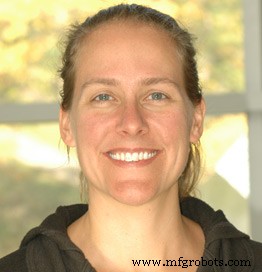
Kira Barton, doctora
Profesor asociado, Universidad de Michigan (U-M)
El atractivo de la fabricación inteligente (SM) para Barton se vio incrementado por las debilidades de la industria reveladas durante la pandemia. “La pandemia ha brindado un ejemplo sin precedentes de la necesidad de mejorar la agilidad y la toma de decisiones inteligente en el sector manufacturero, incluida la cadena de suministro”, dijo. "Esto ha estimulado iniciativas de investigación adicionales y oportunidades de financiación dentro de este dominio, así como colaboraciones sólidas de la industria". Barton y su equipo en U-M crearon un marco de gemelo digital (DT) basado en requisitos que define las especificaciones necesarias para permitir la reutilización, interoperabilidad, intercambiabilidad, mantenibilidad, extensibilidad y autonomía de DT en una amplia gama de aplicaciones. “Creo que el desarrollo de un… marco, así como la demostración e implementación de este marco en varios problemas de relevancia industrial es nuestro mayor logro”, dijo. “Nos gustaría seguir siendo líderes en este espacio”. ¿Y el atractivo de SM? “La fabricación inteligente reúne conceptos de robótica, inteligencia artificial y sistemas ciberfísicos para aprovechar la información para una toma de decisiones más inteligente dentro de la industria manufacturera”, dijo Barton. "Esto brinda una oportunidad única para trabajar en varios dominios en un problema importante para la sociedad".
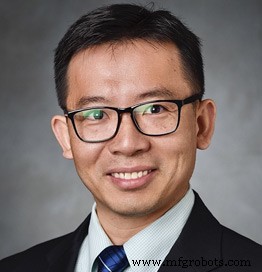
Hui Yang, doctorado
Profesor, Universidad Estatal de Pensilvania
El laboratorio de investigación de Yang se centra en el diseño y desarrollo de nuevas tecnologías de "detección-modelado-optimización" para investigar dinámicas estocásticas no lineales en la fabricación para mejorar la calidad. Entre su trabajo más reciente, Yang y su equipo de investigación diseñaron un nuevo método de privacidad diferencial para permitir protecciones automatizadas para datos confidenciales al agregar "ruido" para disuadir a los posibles piratas informáticos; aprovechó la nueva generación de IoT y la computación distribuida para desarrollar nuevos modelos de red utilizando un enfoque estocástico para el procesamiento de información de máquinas y el monitoreo de condiciones; y diseñó nuevos métodos Six Sigma para el control de calidad de la fabricación aditiva. “Al igual que un ecosistema, tenemos personas que trabajan en esfuerzos aislados en diferentes áreas de la fabricación aditiva, y los ingenieros de sistemas pueden ayudar a conectar los puntos para proporcionar un marco para la gestión de la calidad”, dijo Yang. “La calidad es indispensable, y si diseñamos un marco de gestión de calidad a nivel de sistema desde el principio, entonces tendremos mayor calidad y mejor productividad a menor costo. En última instancia, todo el mundo quiere hacer una fabricación de gama alta y alta precisión, pero si la calidad sufre en cualquier paso durante la producción, se pierde la ventaja competitiva necesaria para el mercado global”.

Eric M. Johnson, doctorado
Gerente sénior, Laboratorio de investigación de fabricación aditiva,
Eaton Corporation
Antes de dedicarse a la fabricación aditiva, Johnson pasó su carrera trabajando en cómo la fabricación afecta a los materiales y, en última instancia, a la durabilidad de los productos. “Luego, en 2013, mi empleador en ese momento decidió comprar una impresora 3D de metal”, dijo. “Como metalúrgico, no podía dejar pasar la oportunidad de trabajar en una tecnología tan genial. Una vez que comencé a trabajar en el campo, mis ojos se abrieron a las oportunidades que la fabricación aditiva (FA) podría brindar al diseño, la fabricación y la cadena de suministro”. Se unió a la comunidad AM, construyó relaciones y aprendió más sobre la impresión 3D. “Le debo mucho a la gran comunidad AM por la increíble tecnología que se ha desarrollado y las fantásticas ideas que han inspirado a los que adoptan la fabricación aditiva como yo”, dijo. Johnson también se inspira en el uso incondicional de AM por parte de Eaton y la dedicación de sus equipos que ayudaron a llevar a buen término la producción AM de piezas aeroespaciales en un tiempo récord. “¡Creo que podemos cambiar la forma en que se fabrica y este es mi objetivo para el futuro!” dijo.

Douglas Bellin
Director general, Fábrica inteligente e Industria 4.0,
Servicios web de Amazon
En su función de supervisar la estrategia general y la hoja de ruta de Amazon Web Services for Industry, Bellin tiene un asiento de primera fila para detectar tendencias en la fabricación. Una tendencia que ve es el rápido ritmo de cambio. “Estamos en un punto de inflexión crítico en el mercado y la aceleración del cambio está aumentando”. él dijo. “En el pasado, el mercado veía cambios que eran de 10 a 20 años en plazos. Ahora, vemos cambios en el mercado y mejoras que suceden en menos de cinco años o antes”. Además, muchas de las tecnologías asociadas con la Industria 4.0, como el monitoreo y las operaciones remotas, la fabricación con autocorrección, la I.A. y el aprendizaje automático, Bellin ahora los considera imprescindibles. Este cinturón verde de Six Sigma, que comenzó su carrera trabajando en todos los puestos de una fábrica de acero, también ve oportunidades en los problemas de la cadena de suministro relacionados con la pandemia. "El apoyo cercano y el reasignamiento de la fabricación son reales y un momento para que las empresas no solo implementen 'lo probado y verdadero', sino que también cambien sus procesos comerciales y pilas de tecnología para que sean más ágiles", dijo.
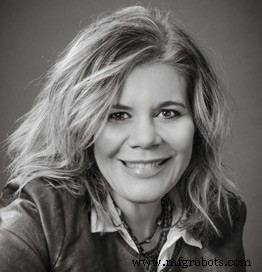
Jennifer Tisdale
CEO, GRIMM
Tisdale es un estratega de cibereconomía conocido por crear programas y estrategias de ciberseguridad para la industria, el gobierno y la academia. Las áreas de enfoque de su empresa incluyen la seguridad de los sistemas ciberfísicos donde convergen el hardware y el software, las redes, las pruebas de seguridad de las aplicaciones, la capacitación y la consultoría. Su experiencia se concentra en la seguridad de los sistemas y tecnologías ciberfísicos conectados, incluida la Internet industrial de las cosas, la infraestructura crítica y la movilidad de transporte avanzada. Tisdale posee una combinación única de experiencia en las industrias de defensa, automotriz, manufactura y tecnología. Anteriormente fue gerente del programa de movilidad cibernética para la Corporación de Desarrollo Económico de Michigan (MEDC). En MEDC, Tisdale fue responsable de apoyar a las industrias automotriz y de defensa al fusionar la movilidad inteligente y la ciberseguridad para avanzar en el desarrollo de vehículos conectados y autónomos. “La tecnología presenta muchos beneficios para la fabricación, pero también riesgos para la seguridad”, dijo. “Me siento inspirado para abogar y educar sobre la importancia de prácticas sólidas de ciberseguridad para que nuestros fabricantes ayuden a proteger sus negocios y la calidad de sus productos. También quiero asegurarme de que todos los fabricantes entiendan que hay recursos disponibles para mejorar su postura de ciberseguridad”.
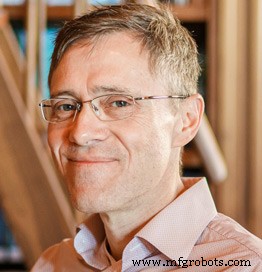
Thomas Bollenbach, doctorado
Director de Tecnología,
Instituto de Fabricación Regenerativa Avanzada (ARMI)
Bollenbach lidera los esfuerzos entre los miembros de BioFabUSA, un programa ARMI, para utilizar la fabricación inteligente para la fabricación de células, tejidos y órganos. Entre sus logros se encuentran una plataforma de fabricación SMAC (escalable, modular, automatizada y cerrada) y un Centro de Caracterización de Tejidos Profundos. También están desarrollando plataformas basadas en sensores en tiempo real y análisis de datos para el control de calidad en proceso y del producto final para superar los obstáculos que se presentan cuando no se aplican los principios de fabricación inteligente. “SMAC y la caracterización profunda permitirán la fabricación de calidad por diseño, que es esencial para que el concepto de décadas de antigüedad de tejidos y órganos fabricados sea económicamente viable”, dijo Bollenbach. En el futuro, ve un aumento en la capacidad de la industria de la biofabricación para monitorear y controlar la fabricación a través de la adquisición y el procesamiento de datos en tiempo real que aprovecha herramientas como A.I. “Veo que esto conduce a un cambio de las prácticas de control de calidad que actualmente se realizan en el laboratorio, utilizando las herramientas tradicionales del químico analítico, a un técnico que monitorea las salidas de los sensores”, dijo Bollenbach. "Esto también conducirá a un cambio en la forma en que las agencias reguladoras como la FDA revisan y aprueban los procesos de fabricación que se les presentan".

Akhila Tadinada
Director de tecnología, Xemelgo Inc.
Nada le da más alegría a Tadinada que crear software para fabricantes. “Los fabricantes son los verdaderos constructores de nuestras economías”, dijo. Ella y un colega de un antiguo empleador establecieron la startup de Seattle en 2018 para ofrecer aplicaciones de Industria 4.0 llave en mano para realizar un seguimiento de las materias primas, el trabajo en curso, los activos, el envío y los productos terminados. “Los asistentes digitales de Xemelgo aseguran que el fabricante pueda concentrarse en hacer el trabajo mientras el software Xemelgo funciona en segundo plano para garantizar que todo esté en orden”, dijo. En busca de inspiración, Tadinada mira a la carrera de su padre en una de las empresas de fabricación de equipos de generación de energía más grandes de la India, donde visitó cuando era niña, y a Amazon. “Amazon comenzó con un pequeño sitio web que vendía libros hace 30 años y finalmente volvió a imaginar todos los aspectos de las operaciones minoristas”, dijo. “Creemos que la fabricación está comenzando en un viaje similar. A medida que tengamos todos los aspectos de la fabricación conectados y el flujo de datos en tiempo real, los fabricantes podrán crear productos altamente personalizados en cualquier momento y atender la demanda de sus clientes finales como nunca antes”.
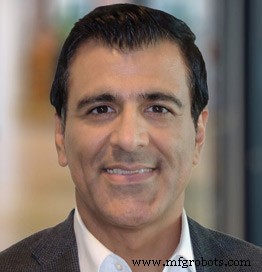
Sachin Lulla
Líder del sector de consultoría en América,
Movilidad y fabricación avanzada, EY
La misión de EY, anteriormente conocida como Ernst &Young, es crear un mejor mundo laboral. Transformar la fabricación específicamente es el núcleo de la misión de Lulla en su papel como líder de consultoría de fabricación. “Nuestro mayor logro ha sido el lanzamiento de nuestro centro de innovación EY-Nottingham Spirk en Cleveland para mostrar el futuro de la fabricación inteligente y la transformación digital para nuestros clientes”, dijo. “Tenemos la misión de asociarnos con todas las empresas de fabricación para transformar sus productos, la experiencia del cliente y la resiliencia operativa con tecnologías digitales junto con nuestros socios del ecosistema en nuestro centro de innovación”. EY también creó un enfoque holístico para transformar las empresas manufactureras con una metodología llamada Transformación Realizada que adopta un enfoque centrado en el ser humano para aplicar "tecnología@velocidad" e "innovación@escala", dijo. Más de veinte años de consultoría con OEM de fabricación de automóviles y la inspiración de su padre cuando era niño, quien fundó una exitosa empresa de fabricación de ropa, claramente han jugado un papel clave en su vida. "Está en mi ADN", dijo Lulla sobre su viaje para dar forma al futuro de la fabricación.
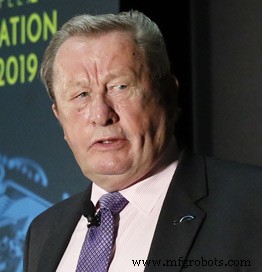
Malcolm J. Thompson, doctorado
Director Ejecutivo, NextFlex
NextFlex, un instituto de Manufactura de EE. UU., creó un nuevo tipo de electrónica basada en circuitos impresos que integran chips electrónicos delgados y flexibles e interconexiones impresas que permiten un rápido tiempo de comercialización, son de bajo costo y se crean a través de un proceso de fabricación ecológico. . “Creamos una asociación con los miembros del consorcio para resolver problemas de forma colaborativa y, al mismo tiempo, construimos una organización de ingeniería y fabricación dentro de NextFlex”, dijo Thompson. “Estos dos logros han impulsado un aumento medible en el nivel de funcionalidad y madurez de FHE (electrónica híbrida flexible)”. A Thompson le gustaría dar la bienvenida a más miembros de NextFlex, actualmente más de 100, para cubrir una gama aún más amplia de la cadena de suministro y ampliar el número de sus socios de fabricación a medida que el instituto trabaja para avanzar en la adopción generalizada de la electrónica híbrida aditiva, la comercialización y las aplicaciones. Crítico para el trabajo de NextFlex es su uso de la fabricación inteligente. “Hemos implementado múltiples métodos de impresión/procesos aditivos para reducir los costos y la complejidad en la fabricación”, dijo. "En términos de ensamblaje de componentes electrónicos, utilizamos una matriz de chip invertible sin soldadura de baja temperatura para que sea compatible con materiales de baja temperatura".
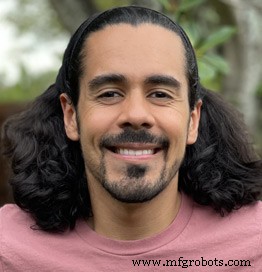
Jay Flores
Fundador, inventar el cambio LLC
Flores combinó su conocimiento técnico con el entretenimiento para hacer llegar a los niños STEM. Tiene un título en ingeniería mecánica y fue embajador global de STEM para Rockwell Automation. También ha trabajado con FIRST. Los proyectos empresariales de Flores incluyen la fundación de Invent the Change LLC, una organización que promueve STEM. Durante la pandemia, cuando la mayoría de las actividades y escuelas estaban cerradas, creó un programa en su canal de YouTube, "No es magia, es ciencia". El programa utiliza el aspecto de entretenimiento de la magia y los experimentos científicos disfrazados de trucos de magia para aumentar la conciencia y el entusiasmo por STEM. “Cada experimento es tan entretenido como educativo y es divertido para todas las edades”, dijo. En su papel como guía de ciencia misteriosa en el equipo de ciencia misteriosa de Discovery Education, Flores fomenta la curiosidad al responder preguntas enviadas por los estudiantes como "¿Cómo se inventaron los ladrillos LEGO?" y "¿Por qué la gente no se cae de las montañas rusas cuando van boca abajo?" Jay is also the host of the innovation competition television show “Make48,” which is filmed for PBS and reaches 96 percent of U.S. households.
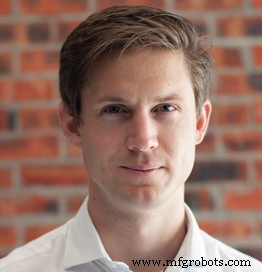
Frans Cronje
Co-founder and CEO, DataProphet (Pty.) Ltd.
When Cronje thinks of the future of smart manufacturing, he sees a pan-operational, self-optimizing ecosystem powered by A.I. but with people at the center. In the plant of the future, humans are empowered to improve their digital skills continuously. This will be necessary as they interface with increasingly smart machines that make new products and components with increasingly advanced materials. “Future manufacturing will also capture value with different metrics such as social and environmental benefit, cross-disciplinary collaboration and scalability of digital capabilities,” he said. Cronje established DataProphet in 2014 when he turned a consultancy into a company. Since then, he and his team of data engineers and data scientists have consistently helped customers reduce manufacturing defects by an average of 40 percent. Some of those customers have even, through DataProphet’s PRESCRIBE solution, achieved zero defects. Cronje’s efforts led to an invitation to join the World Economic Forum’s Global Innovators Community, made up of the world’s most promising startups, and a request to speak at the Annual Meeting of the New Champions, aka the “Summer Davos.”
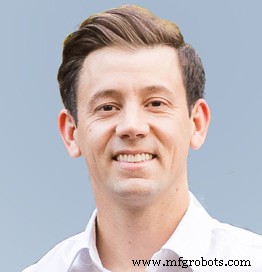
Daniel Burseth
Vice President of Engineering, Eckhart
Eckhart combined a collaborative robot, machine vision and an autonomous mobile robot to make a fully automated, end-of-line inspection system. The system can identify incorrectly placed product decals, bad electrical connections and missing components for a commercial vehicle OEM. “Historically, manufacturers staff many people in inspection roles in which they are armed with a checklist on a clipboard and some basic training,” he said. “Humans are not great at repetitive inspection tasks and quality judgements vary significantly from one operator to the next. Despite best efforts to review quality, many companies end up shipping bad product out the door.” Automation inspection is in high demand as products increase in complexity and skilled labor becomes increasingly scarce. In addition to inspection and testing automation, Eckhart continues to see double digit growth in more traditional factory automation areas including sanding and grinding, machine tending, and the lifting and transport of heavy loads. “Automation is fundamentally about alleviating people from the most dull, dirty and dangerous activities in the factory,” said Burseth. “We take pride in the opportunity to make U.S. factories more desirable places to work.”
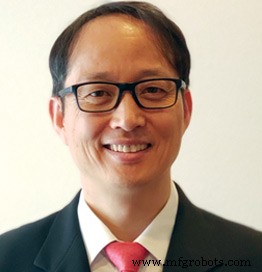
Martin Jun, Ph.D.
Associate Professor, Purdue University; CEO &Co-Founder, Maijker Corp.
Jun co-founded (with fellow honoree Chandra Nath, Ph.D.) Maijker Corp. to commercialize a sound sensor Jun developed to help understand a machine tool’s operation status, condition, process anomalies, health and more, much like the legendary factory worker who could tell by the way a machine sounds if it’s working correctly. He likens the contact-based, internal sensor to a stethoscope to detect each machine’s unique sequence of sounds that can be considered as speech and interpreted. Jun has also developed an immersive and interactive cyber-physical system (I2CPS) framework, which is based on the similarities of smart manufacturing architectures while emphasizing collaboration between humans and autonomy. In general, the autonomy modules are in cyberspace, and humans utilize them from applications. “Especially in the I2CPS framework, human cognition can be substituted for artificial intelligence,” Jun said. “The autonomy can control manufacturing systems instead of humans, and both humans and autonomy share the work of data analysis and association.” Through the work in his lab, Jun hopes to help small and medium-size manufacturers survive and thrive, goals made even harder to achieve during the pandemic, he said.
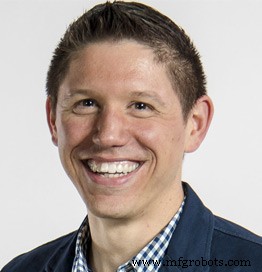
Thomas Hedberg Jr., Ph.D.
Mission Director, Acquisition and Industrial Security, Applied Research Laboratory for Intelligence and Security, University of Maryland
After 15 years working to develop standards and digital capabilities for model-based enterprise (MBE), digital thread and digital twin, Hedberg was recruited to build and lead a research team at the University of Maryland to study how to scale smart-manufacturing capabilities to entire supply chains. “We tell a joke that we started working on supply chain resiliency in early March 2020 when you could count on one hand the number of researchers focused on the topic,” he said. “Then fast forward to mid-March 2020 and the entire world was focused on supply chains.” Prior to the university, Hedberg worked at NIST, where he co-developed the NIST Smart Manufacturing Systems Test Bed that’s used by leading software companies to develop and test their products. The project earned him and his team a U.S. Department of Commerce Gold Medal, the highest honor given by the Secretary of Commerce for “distinguished and exceptional performance,” according to a government website. Hedberg was also instrumental in the creation of the American Society of Mechanical Engineers’ MBE Framework, whose first standard was published in March 2022.
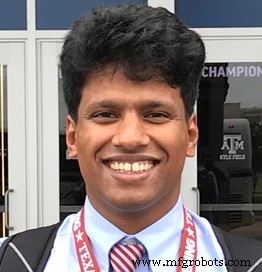
Chandra Nath, Ph.D.
Chief Technology Officer &Co-Founder, Maijker Corp.
When he worked at Hitachi America Ltd., Nath invented a novel signal acquisition method for online monitoring of manufacturing processes and tool condition. A patent has been published. More recently, with fellow honoree Martin Jun, Ph.D., and John J. Murphy, Nath started Maijker Corp. to commercialize an A.I.-based, non-invasive, simple and flexible plug-and-play machine monitoring system that uses a sound sensor that originated in Jun’s lab. Maijker received awards, with Nath as the principal investigator, from the National Science Foundation Seed Fund and Elevate Ventures Inc., Indianapolis, to continue the R&D and commercialization work for the system. Maijker began just as the pandemic started. Despite some COVID-induced initial delays in scheduling industry testing and adoption, the co-founders have been fortunate to sell a software product and already have the initial version of their machine monitoring system in use within their partners’ factories. One of the partners was so successful using the system he wants to deploy it more widely in his factory and offered to compensate the company, a phenomenon Nath deemed “a huge success.”
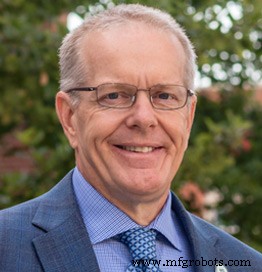
Craig Blue, Ph.D.
Director, Advanced Manufacturing Program, Oak Ridge National Laboratory
During a 25-year career in materials and manufacturing technologies R&D, Blue has amassed patents, publications and awards. But one of his proudest moments was seeing ORNL’s experts in manufacturing and materials, coupled with its facilities and capabilities, help out in the pandemic. He and his team transformed the Carbon Fiber Technology Facility at ORNL to produce N-95 media for face masks, and then transferred that technology to an industrial partner that makes diesel filters to enable the supply chain and production of over 3 million masks a day. They also used the digital thread—a technology Blue’s passionate about—to rapidly produce tooling for face masks and test tubes. In fact, ORNL’s Manufacturing Demonstration Facility, of which Blue was founding director, drove the creation and adoption of the digital framework and data analytics for manufacturing processes. “The digital thread is key to implementing advanced manufacturing and taking American manufacturing to the next level,” he said. “The technology enables companies to fully understand and control their transient manufacturing processes—to ensure part properties and reproduce identical parts time and again.”
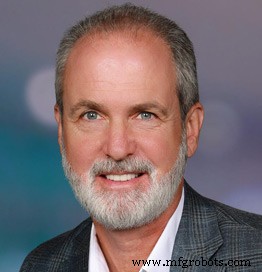
Matthew Cordner
Principal A&D Business Architect, HCL Technologies Inc.
After spending three decades designing, building and supporting vertical-lift aircraft, Cordner is applying his lessons learned to IT. “An aircraft is a complex system of carefully integrated systems, with trade-offs made in each to achieve the desired performance,” he said. “IT architecture is also a ‘system of systems’ designed for higher objectives.” Among the most critical objective is agility—the ability to rapidly sense and respond to daily changes in engineering, the factory and the supply chain, he said. “Billions have been invested in IT tools, yet few companies have integrated them with this overall objective in mind,” said Cordner. “This requires that PLM and ERP systems more effectively integrate to each other and the shop floor. At HCL, we call this Model Based Enterprise 2.0. We see renewed focus on ERP’s role in ensuring supply chain agility and resiliency. Modern ERPs such as SAP’s S/4HANA have been designed to be faster, less complex, more user friendly while providing far more capability than legacy tools.” He offers a gentle reminder:“Remember, the ultimate goal is to optimize your enterprise, not your applications.”
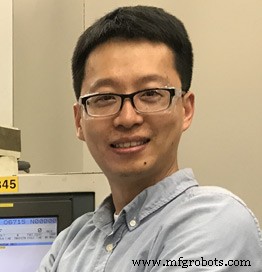
Yujie Chen, Ph.D.
Engineer, Digital Manufacturing and Machining,
Caterpillar Inc.
Chen started his career in manufacturing with Caterpillar in 2013, and has been working in advanced manufacturing-related areas ever since. His work involves developing and implementing manufacturing process modeling, and data exchange and analysis between manufacturing processes. “This is intended to automate the manufacturing process to ensure agility and resiliency,” he said. “For example, a robot can assist in scanning incoming material for variations, and then our advanced manufacturing systems can adjust to these variations more intelligently.” Through MxD, the digital manufacturing institute within Manufacturing USA, he led a team of more than 20 people from academia and industry in a funded project, according to a 2019 article in Peoria Magazine when it named him among 40 Leaders Under 40. COVID-19 illuminated the importance of smart manufacturing, he said. “With smart manufacturing, the manufacturing process status can be monitored, product quality can be predicted and design can be virtually validated,” said Chen. “Some people may be physically far away from manufacturing lines, but they can have even better insight and control of manufacturing with smart manufacturing technologies.”
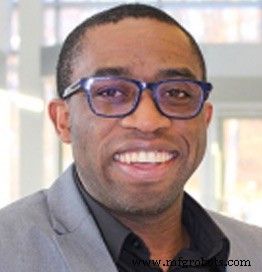
Chinedum “Chi” Okwudire, Ph.D.
Founder and CTO, Ulendo; Associate Professor, Mechanical Engineering, University of Michigan
Okwudire and his colleagues have created new algorithms that leverage control theory, advanced modeling and sensing, and machine learning to boost the speed and precision of desktop and industrial-grade 3D printers at low cost. Manufacturers requested their FBS vibration compensation algorithm to help them speed up their 3D printers to meet the spike in demand brought about by the SARS-CoV-2 pandemic, but it wasn’t ready for commercial distribution at that time. “We were really inspired by the requests,” he said. In the meantime, the team is deploying their solutions on commercial printers. “It’s great to see our solutions leave the research lab and find success in the field,” said Okwudire. “We have lots more smart manufacturing solutions in development—like our SmartScan algorithm for laser-based 3D printing of metals—that we are excited to bring to the 3D printing industry and beyond.” His company’s name, Ulendo, means “journey” or “voyage” in the Chichewa language. The company’s team is on a journey “to use software to enable manufacturing machines to achieve their full potential as ubiquitous tools for modern manufacturing,” according to the company website.
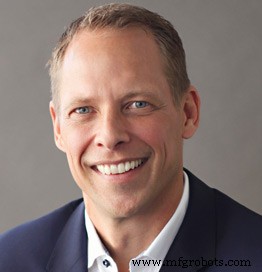
Johan Bjorklund
CEO, Betacom
When Bjorklund became CEO at Betacom in 2019, his vision was for the future. Could Betacom’s wireless infrastructure for mobile operators be at the crossroads of Industry 4.0? He convened wireless industry leaders in finance, engineering, security, product management, sales and marketing to start a new business unit and a new Betacom service—Betacom 5G as a Service (5GaaS)—what the company calls the industry’s first fully managed private wireless service. “We developed a turnkey service, backed by a modern network operations center that manages security in addition to network operations,” he said. Prior to joining the team that acquired Betacom, Bjorklund co-founded and is chairman of the board of a passion project, software company Aiberry. Its software uses A.I. to analyze a person’s words, voice and facial expressions during a short, guided conversation to deliver critical insights to medical providers to help them diagnose and treat mental health disorders. “In a time where mental well-being is more important than ever, Aiberry is increasing access to care, enhancing early detection and enabling healthcare providers,” he said.
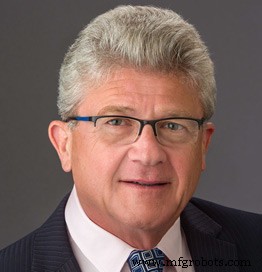
Sam Golan
Founder &CEO, High QA Inc.
In his 25 years of hands-on management experience in CAD/CAM and PLM, it became clear to Golan that smart manufacturing is relatively in a good place and moving in the right direction to address Industry 4.0 challenges. “What is dramatically behind, however, is the quality for manufacturing,” he said. In Golan’s view, quality for manufacturing is decades behind and is a huge bottleneck associated with high cost. Manufacturing automation is highly advanced compared to quality for manufacturing, with the gap growing daily, he said. “Quality can’t keep up with the pace,” said Golan. “Parts are getting smaller, (are) highly accurate with tighter tolerances and are accompanied by huge documentation submissions.” Golan built High QA’s solution by integrating quality and manufacturing from the beginning—2D drawing or 3D model. It has been adopted by close to 1,000 customers, ranging from OEMs to all supply chain levels. Golan’s not stopping there. “Our next achievement begins with a new product launch that enables the supply chain to become an integral part of the manufacturing quality process,” he said.
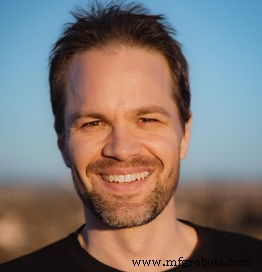
Paul Van Metre
Co-Founder &CRO, ProShop ERP
Van Metre and his partners created ProShop ERP, a paperless, digital manufacturing ecosystem, so they could run their former CNC machine shop using smart tools and processes. When other companies “were very interested” in what they had built, the partners sold the shop they had run for 17 years so they could focus their efforts on the software. “Our team at ProShop has helped bring life-changing impact to hundreds of manufacturing companies, helping clients significantly scale much faster than they could otherwise, reduce costs, increase throughput, improve their bottom lines, create more jobs and improve their communities,” he said. “We believe this is very important work to support this industry and the overall economy.” Industry apparently likes what Van Metre, Matthew Carrico and Kelsey Heikoop created. “The pandemic has led to tremendous growth at ProShop, and we’ve more than doubled our team and client base,” Van Metre said. “Most manufacturing companies have realized they must adopt smart tools to help run their businesses, and that paper documents and legacy software systems won’t allow them to compete at the level needed today.”
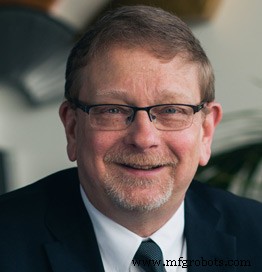
Karla Trotman
President &CEO, Electro Soft Inc.
When the pandemic interrupted industry supply chains, domestic manufacturers moved to strengthen the pipelines by reversing offshoring. “Companies are now realizing that a global supply chain only works if all elements are perfect,” said Trotman. “But what happens when conditions are not perfect? Revenue suffers. Companies are not willing to take that risk, so reshoring is happening at a larger scale and our customers are now asking us to take on larger volumes of work.” There’s a glitch, though, with a shortage of qualified workers. Trotman and other manufacturers in her region of Pennsylvania found their own solution to the issue by banding together 15 years ago and creating the Southeastern Pennsylvania Manufacturing Alliance (SEPMA). Trotman is co-chair. The SEPMA established a boot camp and career pathway to prepare entry-level workers “who at least have a foundation in manufacturing when they walk in the door” for its employer partners. Hundreds of boot camp graduates have been hired. Since starting in 2007, SEPMA has provided technical training to thousands of people and exposed hundreds of middle and high schoolers to manufacturing careers.

David Vasko
Senior Director, Advanced Technology, Rockwell Automation
You might want to call Vasko a pioneer in autonomous control. “Decades ago, I was able to demonstrate autonomous control by applying physical simulation in conjunction with A.I. to create a living replica of a factory, what today is commonly called a digital twin,” he said about one of three critical developments in smart manufacturing to which he contributed. The other two? He was one of the architects who innovated the transition from PLCs to general purpose automation controllers leveraging industrial networks; and he was an architect for functional safety, which enabled the use of easier-to-apply safety controllers and networks to replace difficult-to-use relays. Vasko, who holds more than 75 patents for smart manufacturing innovations, says, “We see the dream we had 20 years ago—to create intelligent, interconnected manufacturing—coming to life each day. I only see this expanding in the future with enhanced supply chain flexibility and resiliency, increased availability of experts as extended reality and A.I./machine learning become easier to use and explain, and a safer, more skilled workforce that leverages the technology to produce in a more efficient, greener way.”
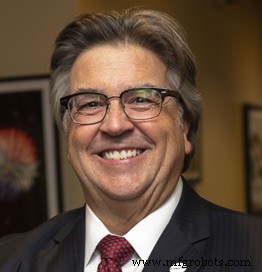
Howard D. Grimes, Ph.D.
CEO, Cybersecurity Manufacturing Innovation Institute (CyManII)
Grimes is helping secure manufacturing operations and supply chain networks, the biggest, most complex targets for cybercriminals. Established in 2020 by The University of Texas at San Antonio, where Grimes is also the associate vice president for institutional initiatives, CyManII has developed early instantiations of a smart manufacturing architecture (SMA) that overlays onto both smart and legacy systems. CyManII has also started to successfully demonstrate how this architecture improves productivity and shrinks the cyber attack surface area. It has also introduced a novel modeling and simulation approach called “CEEQ,” or Cybersecurity Energy Emissions Quantification. “CEEQ allows us to validate and verify the energy efficiency gains and reductions in emissions, and quantitate the extent of cyber hardening achieved via SMA,” he said. As CyManII cyber secures domestic manufacturing Grimes sees, “a smart manufacturing environment that is not subject to theft of IP, where supply chains are resilient and secure and manufacturing sectors become significantly less vulnerable to advanced persistent threats and acts of sabotage by our adversaries. All of this leads to the U.S. being globally competitive.”
Sistema de control de automatización
- Mejora de la calidad en la fabricación:alivio para el director de operaciones
- Tendencias de fabricación:robótica, calidad y eficiencia
- Cómo AR y IIoT están transformando la fabricación
- Cómo la energía inalámbrica está transformando la fabricación
- Qué buscar en un socio de fabricación de uretano
- Desafíos de la fabricación de automóviles y soluciones de IoT
- Mejora de la calidad en la fabricación de automóviles
- GE Digital:transformando la fabricación con Smart MES
- Cómo la tecnología inteligente está transformando el mundo industrial
- Metales para manufactura de bajo volumen y mezcla alta
- Lograr la calidad en la fabricación aeroespacial



